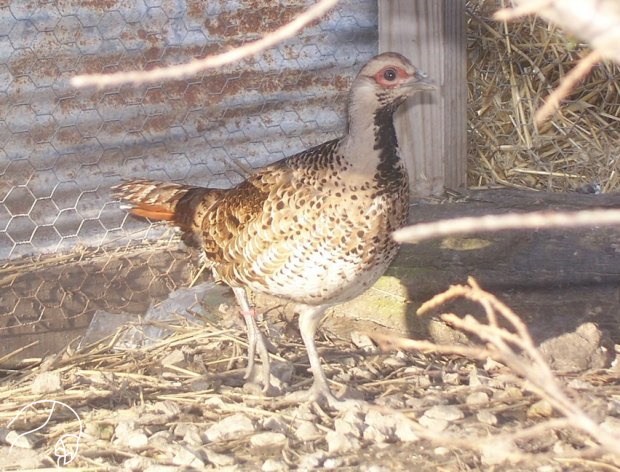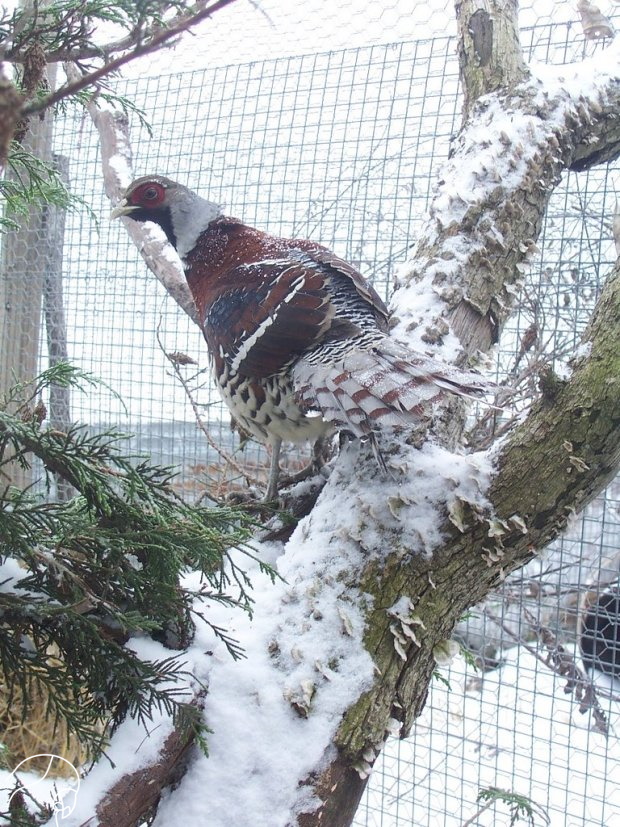Elliot's Pheasant (Syrmaticus ellioti)
The Elliot's Pheasant with its tame and curious nature and stunning plumage has made them quite popular aviary birds.




Scientific classification: Kingdom Animalia, Phylum Chordata, Class Aves, Order Galliformes, Family: Phasianidae, Genus: Syrmaticus, Species: Syrmaticus elliotin
Other Names: Bar-backed Pheasant, Chinese Barred-backed Pheasant
Range: Southeastern China
Subspecies: None
Habitat: Mixed forests to about 6,200 feet.
Status in Wild: Habitat loss and hunting continues to be an issue, although in some parts of the range, the Elliot's Pheasant has adapated to human pressures and has been known to frequent bird feeding areas. The IUCN has listed this pheasant as Near Threatened.
Aviculture: A large pheasant, Elliot's have a curious nature and can become quite tame in the aviary after a period of acclimation. A large aviary is needed with plenty of room for the females to move away from the males who can sometimes get aggressive during the breeding season. In a mixed species exhibit, I wouldn't recommend other galliformes or ground birds kept with this species. We housed them with doves, finches, and hookbills with no issues.
Breeding takes place in the spring, sometimes as early as mid-March in some locations. The females, like most pheasants, makes a simple scrape nest under some type of cover. Our birds would nest under conifers planted in their aviaries. Clutch size is 6 to 8 rosy white eggs incubated by the female for about 25 days.
The captive diet of adult Elliot’s Pheasant consists of a game bird crumble or pellet - we used Purina® Game Bird Maintenance at 12.5% protein during the fall and winter months and increased the protein level to 18% in late winter to early Fall. The chow was mixed with various grains and seeds year round. Whole fruits such as apples, pears, blueberries, blackberries, grapes, and peaches are offered every other day; leafy vegetables such as romaine, leaf, endive, kale, clover, dandelion are offered daily (some only in season); other veggies are chopped or giving whole such as soft corn, peas, broccoli, carrots, zucchini, sweet potato on days when fruit isn't offered. Live food such as mealworms, waxworms, dubia roaches, and crickets are given once a week during the spring and these are dusted with reptile calcium powder. Poultry grit should be available at all times. For the chicks, a high protein crumble is offered, starting at 30% and gradually decreasing with age.
Our Elliot's seemed to enjoy scratching and digging in substrate. I would often add various piles of leaves, mulch (untreated or dyed), and rocks to to the aviary for their enrichment often tossing a handful of mealworms or waxworms in the pile. Pine cones packed with peanut butter and seed was a fun treat as well millet sprays hung in various locations.
Interesting Facts: Named after American ornithologist Daniel Giraud Elliot (1835-1915), author of A Monograph of the Phasianidae (1872) and one of the founders of the American Ornithologists Union.
- Elliot's Pheasant - BirdLife International Factsheet
- Elliot's Pheasant - eBird
- Elliot's Pheasant - iNaturalist
External Links
The beauty and genius of a work of art may be reconceived, though its first material expression be destroyed; a vanished harmony may yet again inspire the composer, but when the last individual of a race of living things breathes no more, another heaven and another earth must pass before such a one can be again. - William Beebe, 1906
Animal Wonders
We depend on our programs & donations to help fund the care and housing for our animals, most of which are either rescues or surrenders. We seem to be always taking in new animals that need a home or different situation, their care adds up. If you would like to help support Animal Wonders, it would be greatly appreciated. We are always in need of donations, caging material, lumber, crates, aquariums, straw, & newspapers.
Contact
Animal Wonders,LLC
Address : 405 W 10th St, Holden, MO 64040
E-mail : info@animalwonders.net
Phone : 816-807-4748

